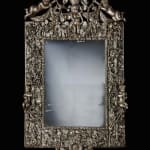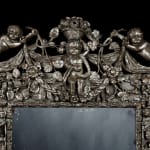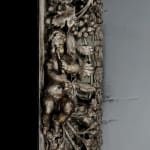A HIGHLY IMPORTANT CHARLES II CARVED AND SILVERED MIRROR
Width: 43.5” 110cm
Further images
Provenance
The collection of Standish Robert Vereker, 7th Viscount Gort (1888-1975) at Hamsterley Hall, County Durham, United Kingdom
Inherited by the Hon. Catherine Mary Wass, OBE (1942-2021) upon the death of her great-uncle, the 7th Viscount Gort
Literature
C. Hussey, ‘Hamsterley Hall, Durham: The Seat of the Hon. S. R. Vereker, M. C.’, Country Life, 21st October 1939, p. 422, fig. 12
J. R. Colville, Man of Valour: The Life of Field-Marshal the Viscount Gort (Collins, 1972)
A Monument to Restoration Grandeur: A Silvered Baroque Mirror and Its Legacy
Monumental in scale, boldly sculpted in high relief, and originally silvered to emulate solid silver, mirrors of this type are exceptionally rare. Few examples survive, among them the mirror bearing the arms of Gough of Old Fallings Hall, Staffordshire—now in the Victoria & Albert Museum—and another incorporating the arms of Fisher of Packington, Warwickshire, held in the Lady Lever Art Gallery, Liverpool.
The practice of silvering such mirrors gave them the dazzling lustre of precious metal, aligning them with a small group of contemporary silver mirrors, like those at Knole and in the Royal Collection, typically supplied en suite with tables and stands as part of grand interior schemes. The putti carved into this mirror draw from French Baroque models of the later seventeenth century, such as a Parisian engraving of c.1670, revealing the strong influence of Louis XIV’s court on English design. This Francophile aesthetic—described as ‘rampant Francophilia’—was enthusiastically embraced by Charles II and emulated by his closest courtiers, who expressed it most lavishly in their country houses, setting the tone for elite taste across England.
Yet, within the English context, these decorative motifs carried particular resonance. The 1660s were a decade of profound recovery following the privations of the Protectorate, and a series of national calamities: the Great Plague (1665), the Great Fire of London (1666), and the Second Anglo-Dutch War (1665–67). In this climate, an opulent mirror such as this would have stood as a potent symbol of national and personal rejuvenation. By the end of the decade, England’s economy had turned decisively upward, buoyed by a flourishing woollen cloth trade and expanding re-export markets. The carved motifs—berries, blossoms, cornucopiae, ribbons, and swags—speak to themes of renewal and plenty, while the musical putti capture the spirit of celebration. The mirror’s large, flat plate would have been exceptionally costly and difficult to produce at the time, embodying both material luxury and the cutting-edge technological achievements of Restoration England.
This remarkable mirror was once in the collection of Standish Robert Gage Prendergast Vereker, 7th Viscount Gort, a distinguished connoisseur whose holdings also included the celebrated André-Charles Boulle cabinet-on-stand now in the J. Paul Getty Museum (77.DA.1). Gort housed his collection at Hamsterley Hall, an 18th-century Gothic revival house built by Henry Swinburne, to which Standish added salvaged architectural elements that reflected his antiquarian eye: Jacobean features from Beaudesert (demolished in 1935), an early 18th-century baroque doorcase, and even a Gothic pinnacle removed from the old Houses of Parliament during restoration.
The mirror’s Baroque splendour made it a fitting centrepiece to this romanticised vision of Restoration culture. It even features a carved sunflower—a symbol of monarchical loyalty made famous by Van Dyck—which would have resonated deeply with Gort, whose family had long demonstrated their loyalty to crown and country. His ancestor John Vereker, a Royalist officer and one of the so-called ‘49 officers’ dismissed by Cromwell, was later rewarded by Charles II for his service and loyalty.
The Vereker family’s legacy of military distinction continued with Charles Vereker, 2nd Viscount Gort (1768–1842), who led the Limerick Militia to victory against the French at Killala Bay in 1798. He inherited the title through the Prendergast family, Norman-Irish landowners descended from Maurice, Lord of Prendergast, who accompanied Strongbow to Ireland in 1179. Later generations added further prestige: the 5th Viscount married a daughter of R. S. Surtees, the celebrated novelist, and served in the Royal Artillery. His son, John Vereker, 6th Viscount Gort—known affectionately to his men as Tiger Gort—was one of the most decorated British officers of the First World War, mentioned in dispatches nine times and awarded the Victoria Cross in 1918 for his bravery at Canal du Nord.
He later rose to become Chief of the Imperial General Staff in 1937 and Commander-in-Chief of the British Expeditionary Force in 1939. As Governor of Malta, he was awarded the Field Marshal’s baton by King George VI in 1943.
Standish Gort himself served with distinction in both World Wars, earning the Military Cross and later becoming honorary colonel in 1948. He and his wife were generous benefactors, donating Bunratty Castle to the Irish people in 1954 and a significant collection of Renaissance paintings to the Winnipeg Art Gallery in 1973. He also oversaw the restoration of Surtees House in Newcastle. Upon his death, the mirror passed to his brother’s granddaughter, The Hon. Catherine Mary ‘Kate’ Wass, OBE, a direct descendant of George III through his son Prince William, Duke of Clarence (later William IV) and his long-time companion Mrs Jordan, the celebrated Drury Lane actress.
Kate’s father, William Philip Sidney, 1st Viscount De L’Isle, upheld the family tradition of service and valour, earning the Victoria Cross for his actions at Anzio in 1944.
This mirror, is more than a decorative masterpiece—it is a symbol of Restoration optimism, a reflection of monarchical loyalty, and a silent witness to centuries of service, culture, and continuity within one extraordinary family.





